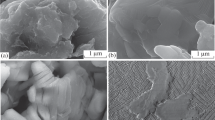Abstract
Ultrasoft x-ray spectroscopy is used to study the dependence of electron energy spectrum parameters in ultrafine TiC powders on particle size. It was established how the relative narrowing of CKα- and TiLα-bands, that reflect energy distribution of valence Cp- and Tisd-states, depends upon the specific surfaces of powders and the charge state of Ti and C atoms. Narrowing of these bands is observed in those energy ranges of the valence band where hybrid Cp+Tisd states are concentrated and it is connected with localization of Cp- and Tisd-orbitals of surface atoms as a result of breaking Ti−C-bonds and dehybridization of the states during powder grinding. Expansion of the test spectra within certain energy intervals during ultrafine powder compaction has been established. It is caused by splitting of Tisd- and Cp-orbitals as a result of forming three groups of bonds (Ti−Ti, C−C, and Ti−C) between the surface atoms of neighboring microparticles as they draw together at high pressure and room temperature. Differences in the interatomic reaction of the surface atoms of nanoparticles in contact within TiN and TiC were determined.
Similar content being viewed by others
References
V. A. Gubanov, E. Z. Kurmaev, and G. P. Shveikin, “X-ray emission spectra and chemical bonding in TiC, TiN, and TiO,”J. Phys. Chem. Solids,38, No. 2, 202–212 (1977).
D. W. Fischer,Band Structure Spectroscopy of Metals and Alloys, D. Fabian and L. Watson (eds.), Academic Press, New York (1973).
A. L. Ivanovskii, V. A. Gubanov, G. P. Shveikin, and E. Z. Kurmaev, “Electronic structure and chemical bonding in nonstoichiometric compounds of refractory transition metals of the IVa and Va subgroups,”J. Less-Common Met.,28, No. 1, 1–17 (1981).
Ya. V. Zaulichnyi, “X-ray spectrographic study of the electron structure and chemical bond in ultrafine powders and microcrystalline materials prepared from them. I. Titanium nitride,”Poroshk. Metall., Nos. 7-8, 75–85 (1999).
A. Neckel, P. Rastl, R. Eibler, et al., “Results of self-consistent band-structure calculation for ScN, ScO, TiC, TiN, TiO, VC, VN, and VO,”J. Phys. C. Sol. Stat. Phys.,9, No. 4, 579–592 (1976).
Yong Nian Xu and W. Y. Ching, “Calculation of ground-state and optical properties of boron nitrides in the hexagonal, cubic and wurtzite structures,”Phys. Rev. B,44, No. 15, 7787–7798 (1991).
Additional information
Institute for Problems of Materials Science, Ukraine National Academy of Sciences, Kiev. Translated from Poroshkovaya Metallurgiya, Nos. 9-10(409), pp. 75–84, September–October, 1999.
Rights and permissions
About this article
Cite this article
Zaulichnyi, Y.V. X-ray spectrographic study of the electron structure and chemical bond in ultrafine powders and finely-crystalline materials prepared from them.3 II. Titanium carbide 0261 0101 V 3. Powder Metall Met Ceram 38, 493–500 (1999). https://doi.org/10.1007/BF02676067
Received:
Issue Date:
DOI: https://doi.org/10.1007/BF02676067




